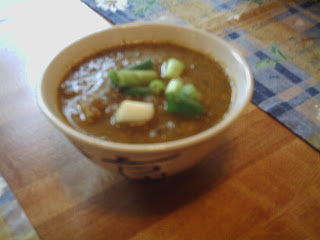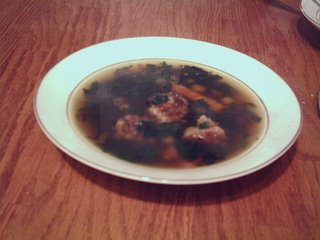
Alice Waters publishes a book on local/sustainable/organic/healthy/fresh/honest cooking, and
the natives are restless. Eating local, organic, healthy, etc., is expensive, elitist and time-consuming, say the critics. Eating local, organic, healthy, etc., is virtuous, good for the planet and easier than you think, say the supporters. I haven’t yet read Waters' book, but my initial reaction is: a pox on both their houses.
Now, I’m above all pro-home cooking: I think everyone can and should cook. I’m also pro reasonably healthy eating—and I don’t buy the argument that nutritious food is more expensive or any harder to prepare than junk (more time-consuming, yes). I like the idea of eating local and often shop at the farmer’s markets in the summer—yet I am inspired by better-tasting vegetables and the fun atmosphere rather than concerns about the well-being of small farms and the environment.
At the same time, I’m on a budget. I’m in grad school; I work at a non-profit. While far from impoverished, I avoid Whole Foods and the local swanky grocery stores. In fact, when resuming this blog, I toyed with the theme of cooking good, nutritious food on the cheap. How cheap? I try to keep my monthly food budget to the low three figures, and generally do, occasional donations from the Food Pantry of Mom and Dad notwithstanding.
A while
back I wrote about how my mom managed to cook homemade, nutritious food on a tight budget as a recent immigrant. She carefully studied the specials and clipped coupons. She bought things that were on sale that week at the cheaper stores. She made huge pots of soup and stew from scratch. No one in the family went hungry or suffered from malnutrition.
And that’s how I manage my food budget these days. I rarely buy anything that’s not on special at the grocery store. I don’t pick up ingredients specifically for a recipe; instead, I work with what I already have in the fridge and the pantry to create my own variations. If I want chili but I can’t afford beef that week, I’ll make a vegetarian version with chickpeas. If I want mahi-mahi but tilapia is cheap that week, I’ll adapt a recipe for tilapia. I often stock up at Trader Joe’s and Lena’s, a depressing local supermarket that sells shockingly cheap fruits and vegetables under the glare of fluorescent lights. Cauliflower for .39 a pound; red peppers for .99, plums for .79. It’s not remotely local/organic/virtuous, but then, it lets me make nutritious, varied food while sticking to my budget.
Is it convenient to cook healthy food from scratch on the cheap? No. Unless you truly enjoy food and cooking, it’s a pain in the ass. My mom saw cooking as a duty, something she had to do as a wife and mother, whether she enjoyed it or not. (I can count on one hand the number of times she has ever said, “I don’t feel like cooking. Let’s get takeout.” That’s not what Soviet immigrants do.)
I’m with Waters all the way about the pleasures of eating and playing around in the kitchen. I like food and all the rituals associated with it. I like planning meals, I like shopping for ingredients, I like chopping and sautéing. I like sitting down to a leisurely meal, whether it’s
en famille or just me and a week-old
New Yorker. I avoid eating in the car or on the run between phone calls and e-mails.
I don’t mind putting time and effort into cooking, even if it’s just for myself. I value homemade chicken stock and farmer’s market potatoes. Making stock isn’t a huge effort, but you do have to baby sit it for a couple of hours as it simmers on the stove. The farmer’s market is open Saturday afternoons but it’s still on the other side of town. That means I have to plan ahead. I’ve cut short studying sessions at grad school to make it to the market before it closes. I sometimes find myself in the kitchen at midnight simmering that stock. For me, all that’s fun.
But what if cooking isn’t fun? Then there’s no way you will rearrange your schedule stand over a hot stove or trek to the market for local potatoes. Sometimes I wonder what normal, twenty-something girl would find herself making chicken stock into the wee hours of the morning when a) she has a full time job b) there is a pile of school work to be finished c) she could be going out and socializing. No normal twenty-something something girl would do something like that, unless she has a freaking food blog. Actually, hardly anyone but a food blogger would.
Food isn’t all that important to a lot of people. Yeah, they like nice food when it’s made and served to them, but relatively few people rhapsodize about beautiful produce, risotto-stirring and leisurely dinners. Making homemade stock or going out of the way to buy local potatoes holds as much appeal to them as Nascar racing does to me. And you
really have to like food to follow Waters’ commands: shop at farmer’s markets, know the people who grow your food, cook at home. What Waters is ultimately promoting, I think, is an upscale lifestyle hobby, comparable to vacationing in Napa or reading memoirs about remodeling one’s villa in Tuscany. That’s why some people bristle when confronted with Waters’ book. Her expensive hobby is their drudgery, drudgery they don’t even have money for. Me, I wish I could afford what she’s selling. But most just don’t care that much.



 My mom and I cut the fish into sections, removed the skin and bones, and dug in. You can eat smocked mackerel spread on rye bread, with slices of cucumber and tomato. Or you can pick up the soft, fatty chunks with your fingers and pop them in your mouth, letting the fish melt on your tongue.
My mom and I cut the fish into sections, removed the skin and bones, and dug in. You can eat smocked mackerel spread on rye bread, with slices of cucumber and tomato. Or you can pick up the soft, fatty chunks with your fingers and pop them in your mouth, letting the fish melt on your tongue.











